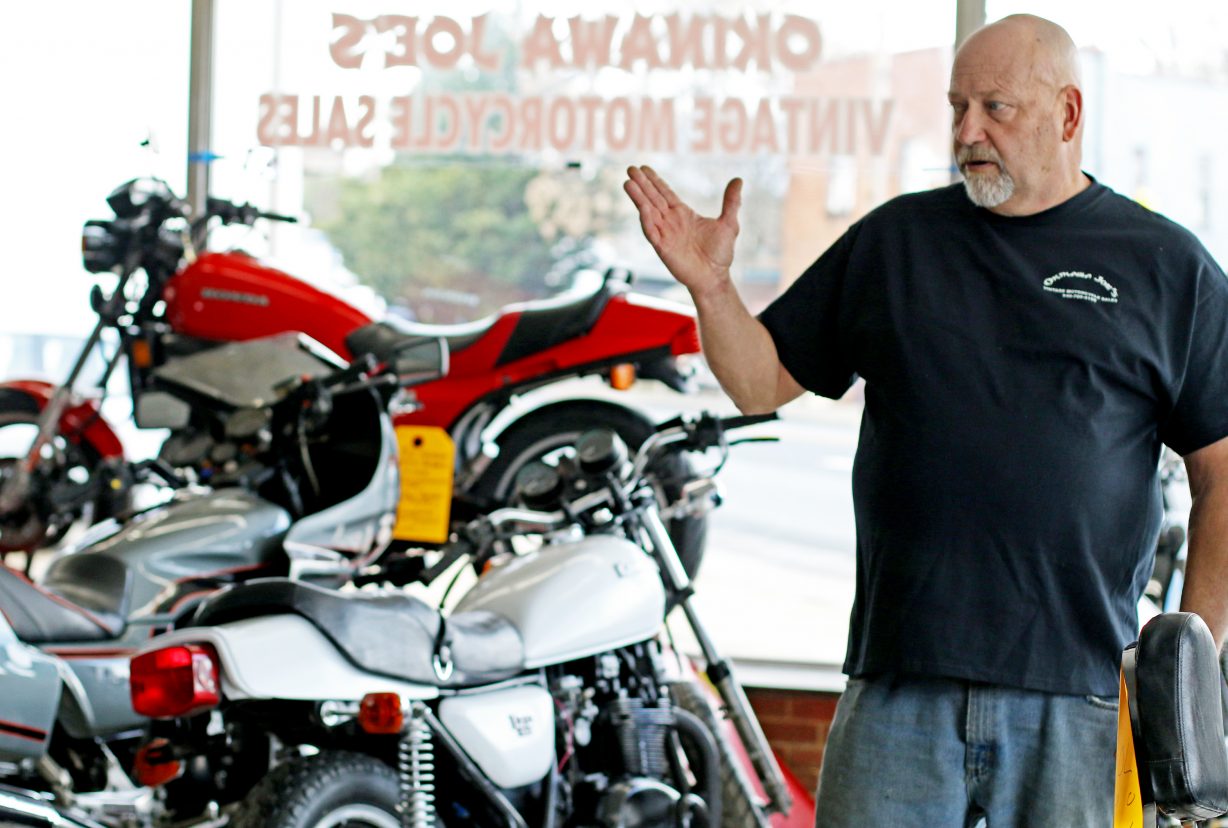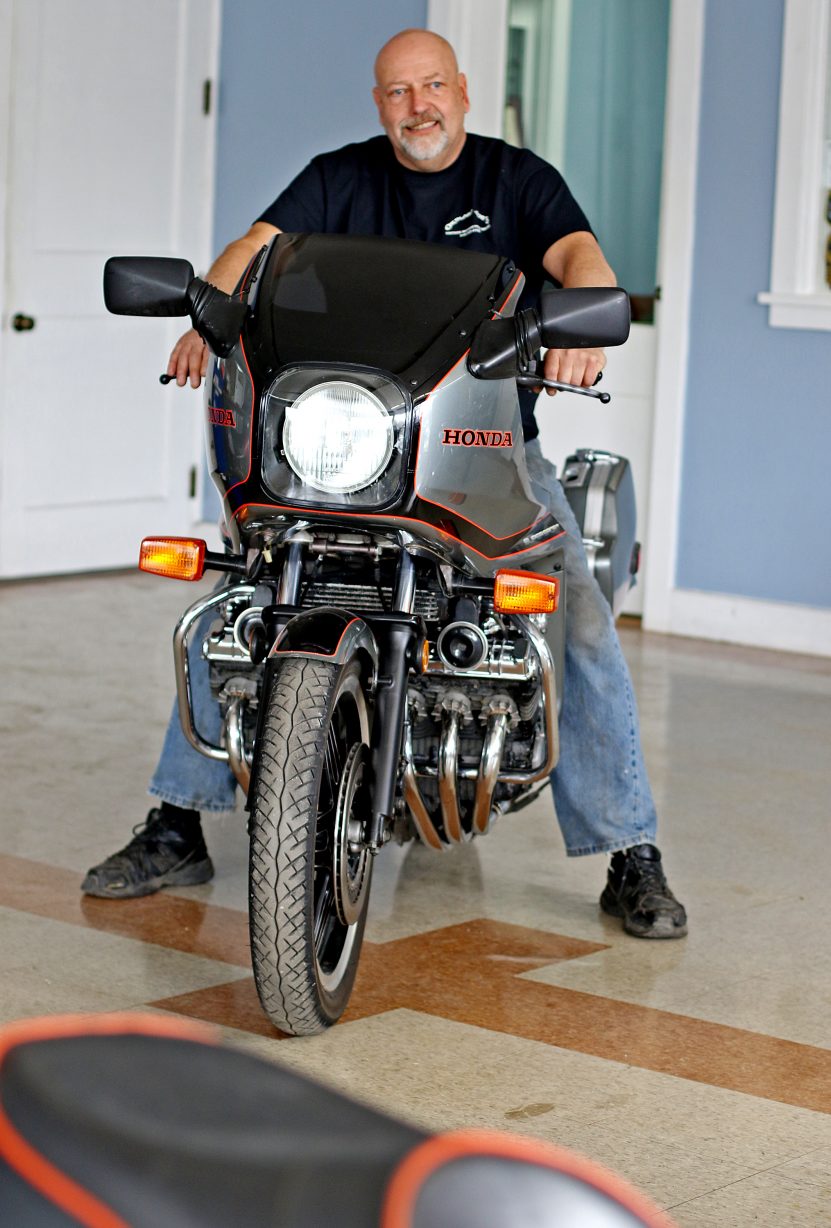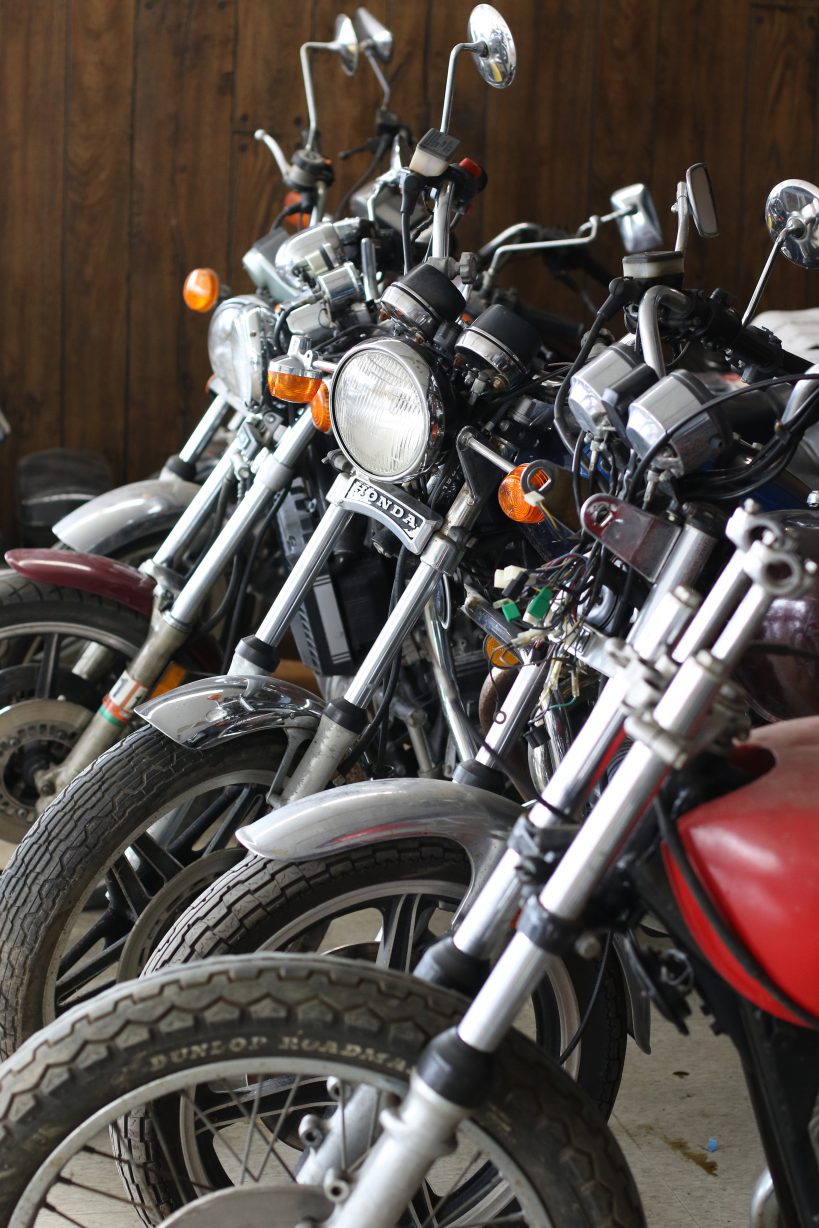
By Jeremiah Knupp, senior contributor // Photos by Holly Marcus, senior contributor

The kitten just showed up on the doorstep at 690 North Main Street, his physical defects obvious, and probably the reason his previous human had abandoned him. But where others may have only seen a terminal case John Garasimowicz saw potential, feeding the little cat, taking him in and dropping the cash at the vet to patch him up.
“I’m a sucker for animals too,” he says.
The “too” in his statement reflects Garasimowicz’s first passion — machines of the type that surround us as we stand in the showroom of his business, Okinawa Joe’s Vintage Motorcycle Sales. If you’re looking to understand Garasimowicz’s business model, that kitten may be the best example. He takes old motorcycles, often abandoned and neglected, restores them to perfect functioning condition and passed them on to a new owner who he knows will appreciate and care for them. Like a hardcase stray that’s finally turning into a lap cat, Garasimowicz feels, one year in, his efforts are finally starting to pay off.

The Man
John Garasimowicz has had grease under his fingernails as long as he can remember. He started off as a child, helping his engineer father with his weekend hobby of getting old vehicles going again, worked his way through college as a car mechanic and continued to wrench in his spare time through a decades-long career as a shop teacher. It was a world that included two wheels as much as four. Garasimowicz got his start with motorcycles with a 1974 Honda CB360 that he purchased at age 17 while in college.
“I liked the fact of how fun and light the Japanese motorcycles were and how easily they handled. To me it was a natural match. I rode my little 360 everywhere,” he recalls. “As I started to work on them I was just impressed with the simplicity. The Japanese were geniuses. The motorcycles were so nicely engineered and had a lot of power for the size.”
Two things brought the Connecticut native to the Valley — local teaching jobs (he retired from Harrisonburg High School in 2017) and the motorcycle-friendly mountain roads and mild climate of the area. Two years ago, Garasimowicz had a vision that vintage motorcycles could move from part-time hobby to full-time business.
“I came to a life decision once I stopped teaching. I could work on cars, but in my 60s, crawling around under cars, it just isn’t that pleasant anymore. Here in my shop I can sit and put a bike up on a table and work on it and it’s pleasant,” Garasimowicz says. “And you get to ride the finished product when it’s done. That’s the biggest thing — when you birth them. It’s something that hasn’t run in 20 years and you hear that engine fire off and you’re just like ‘Wow.'”

If you were looking for an idea for a successful business, motorcycles may not be the best choice. The industry took a nose-dive during the 2008 recession and has never recovered. Retail motorcycle sales are at their lowest point in decades, with older riders aging out of the market without a new generation rising to replace them. In a digital world, motorcycle riding is a decidedly analog pursuit. There’s no room for “virtual” in its asphalt-meets-rubber reality. But Garasimowicz thinks he’s found a niche within the two-wheeled world where he can be successful.
“I saw that my own motorcycle, which I bought for $3,000 in the ’90s, was now worth $10,000 and I said ‘There is a market for vintage Japanese bikes,'” he recalls. “I was at the point where I could say, ‘Let’s try this and see what happens.'”
In spite of the industry trend, the business is even attracting younger riders.
“The market is going in two directions. There are the people in the 40 to 60-year range who still ride and love the old machines and I’m getting young people in their 30s who have investigated the hype and love this genre of motorcycle,” Garasimowicz says. “It makes me feel that this will keep going, that these machines will still have an audience..”

The Machines
The 1970s and ’80s represent the heyday of Japanese motorcycles. As the traditional powerhouse motorcycle builders in the United States and the United Kingdom were faltering, Japanese manufacturers stepped in, combing cutting-edge technology, quality and performance in an affordable and practical package. Case in point, the two 1981 Honda CBX motorcycles sitting in the Okinawa Joe’s showroom. A technology tour-de-force, the CBX is a machine that is wrapped around a massive six-cylinder, air-cooled engine that features dual overhead camshafts, six individual carburetors and six chrome headers that sprout from the front of the engine like the rank growing out of a pipe organ. Derived from Honda’s Grand Prix racing machines, it was the fastest production motorcycle of its day.
Okinawa Joe’s is a showcase of this time period, when manufacturers were freely experimenting with what would make the best modern motorcycle. The results are legendary. A Kawasaki H1 two-stroke (think 60-horsepower, three-cylinder chainsaw), a motorcycle whose power-to-weight ratio quickly earned it the nickname “The Widowmaker,” sits front and center awaiting restoration.
Resurrecting an old motorcycle is no overnight project. Carburetors are shellacked shut with a varnish of dried gasoline. Brake fluid has corroded and seized calipers. The elements have taken their toll on aluminum and chrome. Most motorcycles take an average of three to four months to rebuild, some of that period being down-time while waiting for obscure parts sourced around the country to arrive. The complete set of six carburetors on the CBX took Garasimowicz a week’s worth of work to rebuild. The final product is no “antique” or museum display. They are “vintage” in the sense of a bottle of wine that has become complex, unique and rare with age, not meant to sit on a shelf, but destined to be uncorked.
“There’s instant recognition when you pull up someplace on an old bike. I’ve been riding around town on a CB750 over the last couple of days and people are just craning their necks to look at this beautiful motorcycle — all the chrome and all the touches on it that you don’t see on modern bikes,” Garasimowicz says. “These bikes feel old and smell old. There’s a certain soul and a certain personality that people just love.”
“We all want to go back to our early years of driving and riding,” says John Serrell, the owner of the building that houses Okinawa Joe’s. “People just smile when they come in here because they see things that they haven’t seen in years.”
But, like restoring a neglected motorcycle, getting a unique business off the ground was no overnight job.
“At first, I didn’t sell a bike for six months and I was scared because I’m putting my personal money into this. Starting a business is a gutsy move. You’re basically rolling the dice on something that could work or not,” Garasimowicz says. “All of the sudden it started picking up. I think it was just a matter of getting my name out nationally that I have these bikes. I get calls from all over the country. I rely on one thing — the passion that people have about motorcycles. The biggest thing that I have gotten out of this are the connections with people.”

The Place
Whether the concept or the location came first is a chicken-or-the-egg question. If the idea for a vintage motorcycle business was the fuel, then the building at 690 North Main Street was the ignition spark.
“I saw this place open up and my idea immediately was, this place must be motorcycles,” Garasimowicz recalls.

Originally built as a dealership for the short-lived Tucker brand of automobile, the building served as Royal Motor Company, a Lincoln and Mercury dealership, in the 1950s and ’60s. Since then it’s had a variety of tenants, most recently an auto parts store. Garasimowicz started renovating the space on the weekends in August of 2018, cleaning and fixing things like “a toilet that looked like for decades, people came to work on Saturday morning with a hangover and barfed in it.” Months of patching, painting and scrubbing the grime from the huge plate glass windows that front both Washington and Main streets culminated led up to an opening on May 1, 2019.
The resulting space oozes vintage, from the psychedelic custom ’70s paint job on the tank of a project bike to the Easy Rider Captain America helmet resting by a window. It has that quirky, DIY-feel that fits perfectly in to the ethos of Harrisonburg’s north end community.
“The Little Grill has been great for my business, because if folks have a little bit of wait time to get in there, they’ll bring their kids and just walk the block up to my place and come in and look,” Garasimowicz says.
“It’s absolutely divine to have new activity on Main Street. We’re not in the ‘renaissance’ of downtown, but the city is still growing all the way to the city limits and we are in the middle of that and it’s wonderful to have somebody down here that is a unique business,” Serrell says. “Nobody is doing this type of activity. It’s fun to have people from all over the East Coast coming here because there is an interest in vintage bikes.”
“This wouldn’t be possible without John,” Garasimowicz says of fellow gearhead Serrell. “He saw my vision and supported me. He’s a vehicle guy and having vehicles in that space again just appeals to him. It’s a nice fit for both of us. I couldn’t ask for a nicer arrangement. The history of the place is so cool and it’s just a beautiful location. I’m a spiritual guy and I just got this special feeling that this place was crying out to me, ‘Bring me back to my former glory. Get chrome inside here again.’ And I said, ‘This would just be such a cool retail space for old machines.'”
Which brings us to the name…

The Vision
“My girlfriend has this three-foot Buddhist monk statue. Her dad was in the Marines and when he was in Okinawa he brought the little dude back. And I always referred to him as ‘Okinawa Joe,'” Garasimowicz relates. “I thought it was a fitting name for this business. With my background in Buddhism, it was just calling to me. So I thought, why not call it ‘Okinawa Joe?'”
He commissioned Staunton artist Grail Ogzewalla to design the logo, a Buddhist monk wheelieing a CBX, his beard blowing in the wind and his face split with a grin. The more-than-passing resemblance to Garasimowicz, with his shaved head and goateed chin, is no coincidence. He’s not the first person to make the connection between spiritualism and turning a wrench. Another thing that grew alongside the popularity of Japanese motorcycles in the 1970s was an American fascination with Zen Buddhism. A connection between the two was obvious. Robert Pirsig’s 1974 classic Zen and the Art of Motorcycle Maintenance became an overnight best seller.
Old motorcycles feature technology that has disappeared from modern automobiles, things like carburetors and ignition points. Working on them puts the mechanic in contact with the primal mystery of internal combustion — the swirling of that precise mixture of fuel and air, the timing of the spark at just the right instant to ignite it when as it is compressed by the piston against the cylinder head, and the opening and closing of each valve as the engine organically breathes in and out. In contemporary vehicles most of those functions are controlled by an electronic sequences of 1s and 0s that emit from a sealed black box with a mechanic needing to be as familiar with a serial port and a laptop as he is with a wrench. Not so on a vintage machine. Everything is mechanical, in the purest sense of the word, the wrenching of which requires the precision of fingers and acuity of ear drum of a concert musician.

“You become one with what you’re working on. You get lost in your work and become part of it,” Garasimowicz says. “Those that discover it and find what it is about, whether it’s working on a motorcycle or building a house, it’s a type of meditation.”
Right now Okinawa Joe’s is a solo act for Garasimowicz, though his three sons volunteer at the work bench when they can. But just like the space it fills and the bikes it collects, Okinawa Joe’s is a work in progress.

“I’d love to see this business expand three fold and have three to five mechanics working on these things so were could get more machines out of here,” he says. “My idea is to have it support itself and create a service for people and my joy is working on these old machines and meeting the people. It’s like putting up something for adoption. I just hope the right person gets it. You can have a business and you can make money, but you can also have that human connection. That’s what I like about this. Motorcycles have that human connection.”
“Joey” the cat is home recuperating from his latest visit to the vet when we stop by Okinawa Joe’s. Garasimowicz expects him to return soon, resuming his role as the live-action maneki neko that greets customers as they come in the door and curling up to sleep on the seats of parked bikes during his downtime.. It’s just another living connection formed at Okinawa Joe’s, a place where vintage motorcycles teach you to see potential where others see derelict.
Journalism is changing, and that’s why The Citizen is here. We’re independent. We’re local. We pay our contributors, and the money you give goes directly to the reporting. No overhead. No printing costs. Just facts, stories and context. Thanks for your support.














